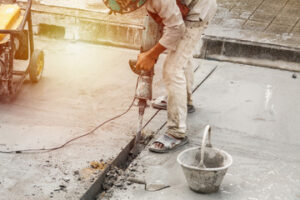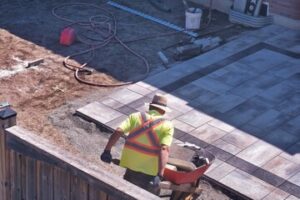Concrete is an integral part of a building’s structure and appearance. However, like any construction material, it can become damaged and require repair.

A professional contractor like Concrete Repair Eau Claire has the proper tools and materials to assess the damage and ensure a quality repair. They can also guide preventative maintenance to avoid future problems.
A crack stitch is a carbon fiber grid that spans concrete slab cracks and repairs them. This carbon fiber / Kevlar open grid design creates a bond far stronger than any other concrete repair product. It is non-corrosive and extremely simple to install. It requires just one saw cut per stitch, which can be performed with a standard circular saw and concrete blade. Just fill the cuts with epoxy, insert the stitch and your cracks are gone! Tests in a certified lab prove that this stitch is up to 2-4 times stronger than its competition.
In general, crack stitching is used to reinforce concrete structures that are undergoing significant stresses or overloads due to temporary or permanent conditions. Such conditions might include unforeseen use or heavy loads, changes in soils or water tables, and subsidence. This type of damage may also result from unforeseen construction or maintenance activities.
The structural crack bridging/stitching solution that has been most commonly used in the past is the metal concrete staple, also known as “concrete stitch.” A staple or stitch consists of a long length of metal, drilled through the slab, then anchored to the concrete with epoxy. The metal staple has high tensile strength, but the problem is that it can break when it is exposed to loads and pressure.
Newer carbon fiber concrete crack bridging stitches are an evolution of this method. They are light weight, durable (10x stronger than steel), easy to install, and can be painted or covered with a finishing material, making them perfect for a wide variety of residential and commercial concrete repair applications.
Rhino Carbon Fiber Concrete Crack Stitches are a fast and cost effective way to repair concrete cracks. They are an alternative to U-bar and concrete rebar, with the added advantage of less labor. They are also much easier to work with than traditional concrete staples, as the process is quick and easy.
Stitching is generally not recommended for transverse cracks in CPCD as these can cause a differential movement between the two sides of the slab. This can lead to stress buildup elsewhere in the slab that eventually leads to spalls and new cracks. However, longitudinal cracks in CPCD do not deteriorate as rapidly and can be repaired with stitching.
Routing and Sealing
Suitable concrete crack repair methods depend on the crack width, depth and type, as well as whether it is structural or remedial. Using the appropriate concrete repair method for each situation will save time, money and energy in the long run and prevent further problems down the road.
Concrete cracks occur in structures due to a number of factors, including temperature fluctuations, shrinkage and chemical degradation. Regardless of the cause, they can lead to structural damage and compromise the integrity of the structure. It is important to address these issues promptly and effectively, to protect the safety and longevity of the concrete or masonry structure.
One of the most common techniques for repairing concrete cracks is stitching and sealing. This method involves bridging the crack with U-shaped metal units and is often combined with grouting to reinforce the concrete, resulting in a structurally sound building. This method is very effective and relatively inexpensive.
Routing and seal is another popular choice for concrete crack repair. The procedure involves enlarging the crack to establish a full-depth joint and then filling it with a resinous material. This can be combined with other materials to improve its performance and enhance the durability of the structure, such as skid-resistant aggregates.
Before applying any crack sealing treatment, it is important to thoroughly clean the cracked surfaces. This can be done using high pressure air blasting, hot lancing or wire brushing. This will remove dust, debris and loosened asphalt concrete fragments. In addition, it will reduce the risk of adhesion failures between the cracked surface and the sealant.
The most important step in determining the best concrete crack repair method is evaluating the crack for its causes. If the cracking is due to moisture shrinkage, it may be possible to use a moisture tolerant epoxy to treat it. However, if the cracking is caused by a continuing foundation settlement issue, it will be necessary to correct the underlying problem before cracksealing can be successful.
Epoxy Injection
This method is a structural crack repair technique that uses epoxy injection to fill and “weld” cracked concrete back together. It is commonly used to restore load-bearing walls and below-grade structures such as foundations, retaining walls, abutments, pool decks, and dams. It can also be used to repair concrete slabs and structures damaged by vibration, earthquakes, overloading, vehicle impact or loading, or other factors that cause cracking and voids.
Before injecting, the crack surface will be cleaned thoroughly. Wire brushing, vacuuming or pressure washing may be necessary to remove dirt and debris from the cracks and voids. The surface must be clean and dry to ensure good adhesion between the injection material and the concrete. Surface port adhesive (Sealboss 4500 crack sealer epoxy paste) is then applied to the surface of the concrete substrate and to the base of each injection port. Surface ports are short rigid plastic tubes that serve as entryways to the cracks. They are typically spaced an inch apart and are positioned directly over the cracked areas.
After the surface ports are installed, the cracks will be injected with the epoxy injection system. The injection process will be repeated until the cracks are filled and epoxy is no longer flowing from the injection ports. It is important to keep an eye on the cracks and their progress during this process, as it is often difficult to determine how far the cracks extend below the surface of the concrete.
Epoxy injection is an effective solution for repairing large cracks, voids and delaminations in concrete structures like industrial machinery bases, parking garages and other commercial buildings. It can also be used to stabilize and strengthen concrete walls, slabs, columns and beams. Epoxy injection can be a cost-effective and fast way to repair concrete cracks, fill voids and stabilize vibrating machine bases.
Vector Construction offers a complete line of crack injection materials designed for use in two component mixing and metering injection equipment. Our products are 100% solids, low viscosity epoxy adhesives that are designed to be injected into cracks in concrete. They are specifically formulated to weld and bond to concrete, creating an excellent strength to weight ratio. They are ideal for restoring cracks and voids in concrete, sealing leaks, and stabilizing structures subject to vibration during installation.
Urethane Sealant
There are a variety of different sealants available for use, including silicone and polyurethane. Both offer a wide range of benefits, such as keeping water and air out of joints, resisting movement, and increasing aesthetics.
The key difference between these two types of sealants is the chemical makeup. Silicone sealants are based on silicon, while urethane is based on polymer chemicals. While the difference may seem small, it is important to note for those looking to choose the right sealant for the job.
Polyurethane is an extremely versatile sealant that can be used to seal joints in concrete, masonry and asphalt. It is highly abrasion resistant and provides an excellent resistance to weathering and UV rays. This makes it a great option for outdoor use in harsh environments. Additionally, it is an effective insulator and can help to lower energy costs.
There are a few different types of polyurethane sealants, and each offers its own set of benefits. One of the most common is Sikaflex, a line of professional-grade sealants designed for a wide variety of construction applications. This sealant is highly abrasion-resistant and can be used to seal contraction and expansion joints in concrete. It also helps to keep dirt, ice and other pollutants out of cracks, which prevents damage to the concrete surface.
Another option is the Loctite PL Concrete Self-Leveling Polyurethane Sealant. This is a high-performance polyurethane sealant designed to be used in construction and industrial applications. This sealant is a low VOC formula and meets strict federal and state guidelines. It is a highly abrasion-resistant and durable sealant that can be used to seal contraction joints, expansion joints and control joints in concrete surfaces. It can withstand exposure to heavy pedestrian and vehicular traffic, and it is easy to clean up after application.
Both of these options are great choices for sealing construction joints in concrete. However, it is important to remember that these sealants can be toxic if not handled properly. Therefore, it is always a good idea to seek professional assistance when working with any type of sealant. The expert will be able to ensure that the sealant is applied correctly, and that the proper safety precautions are taken.
